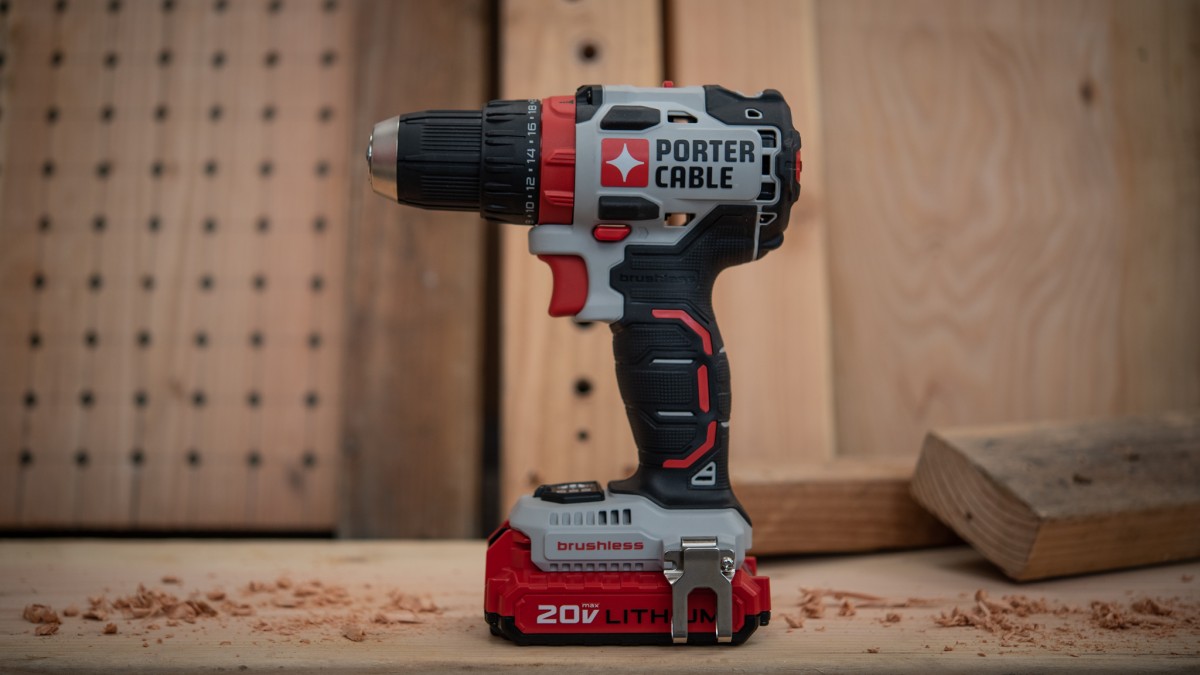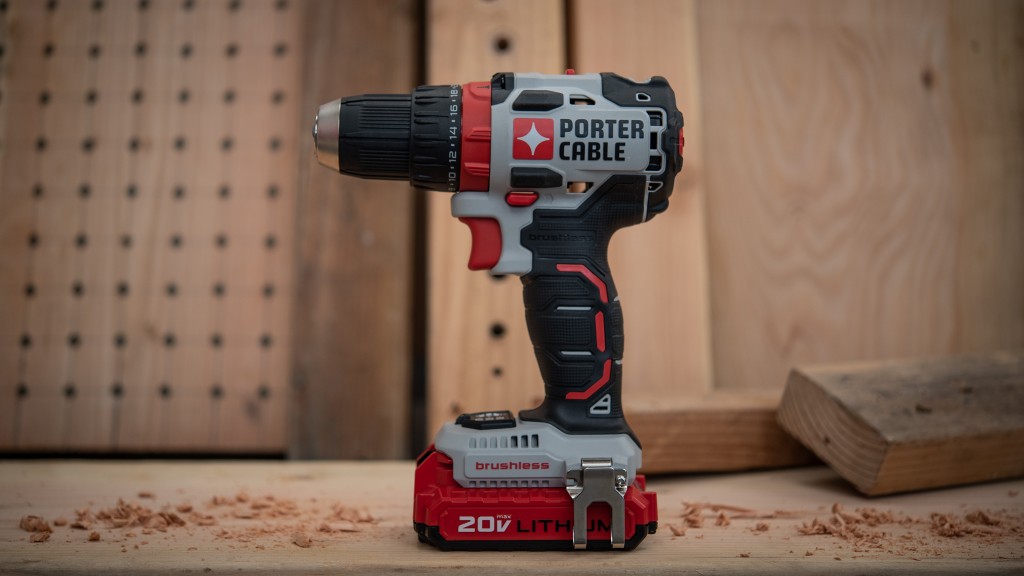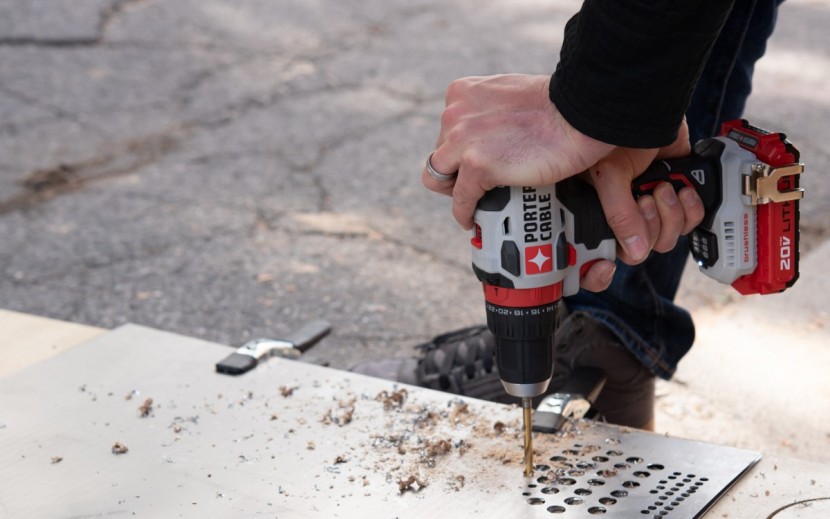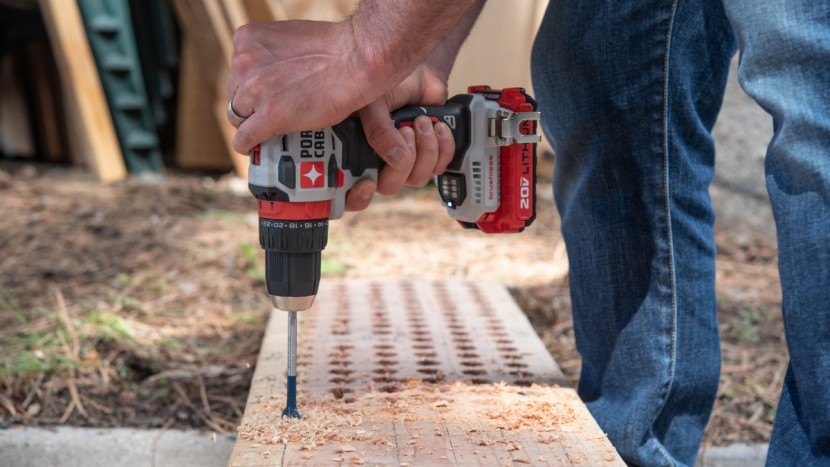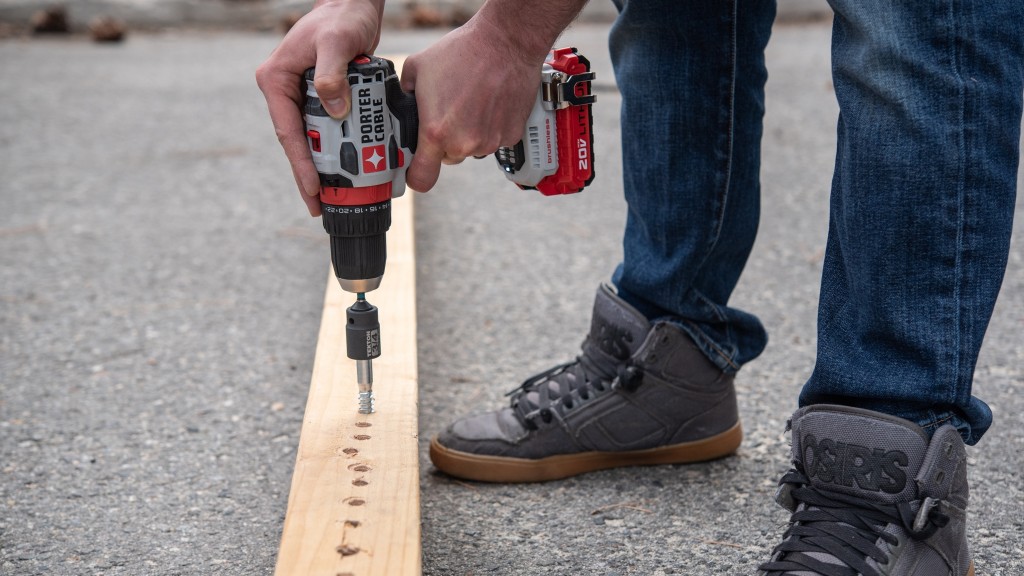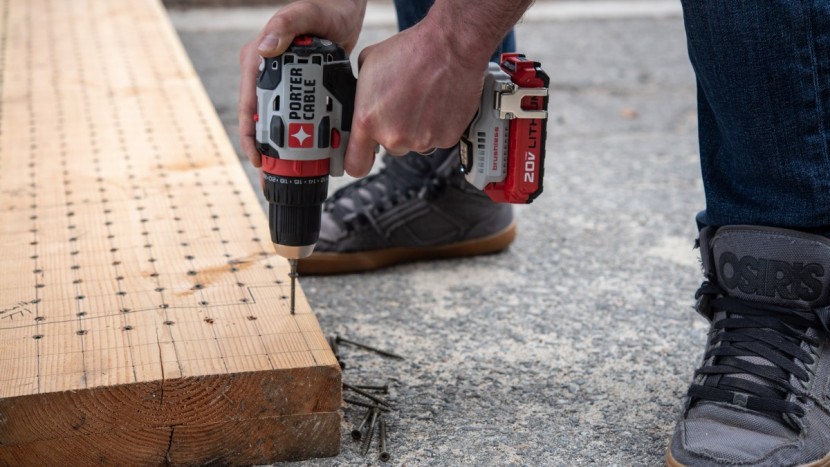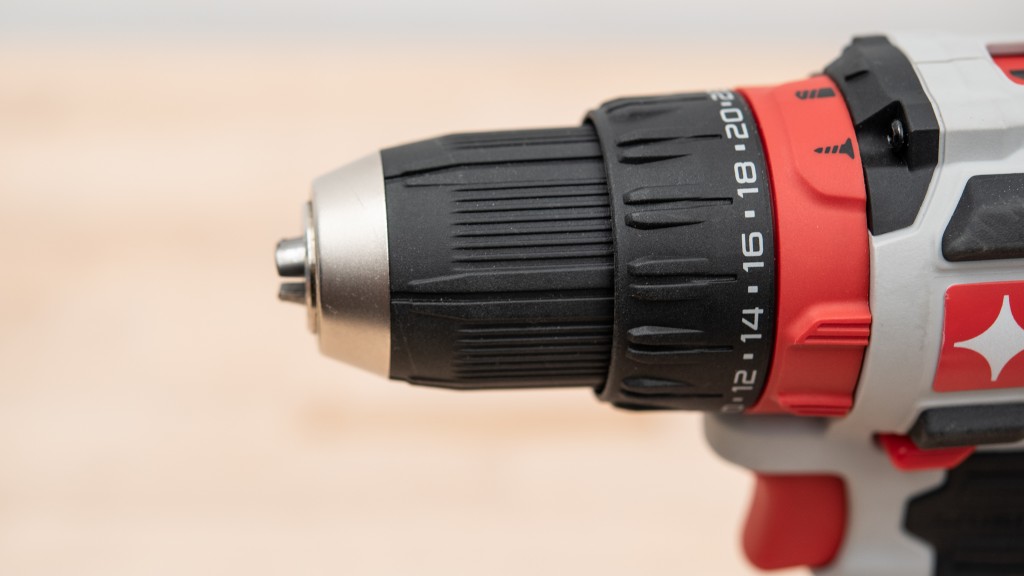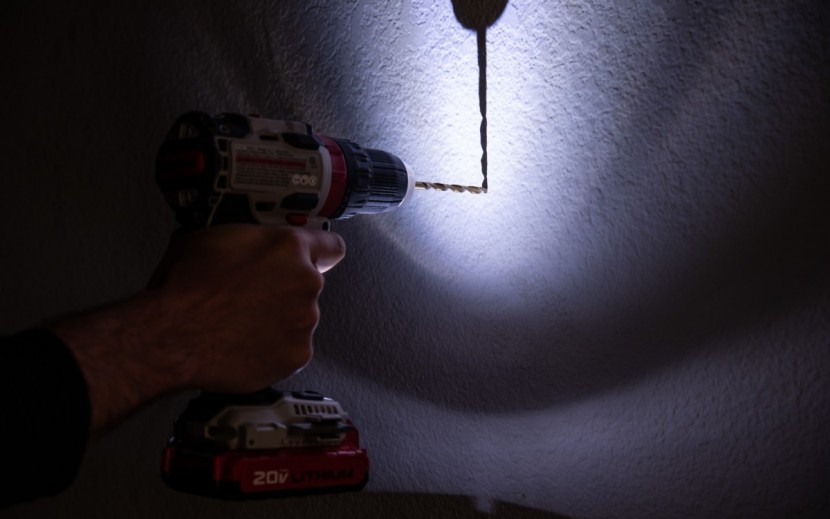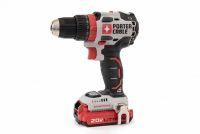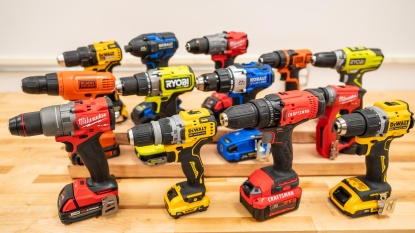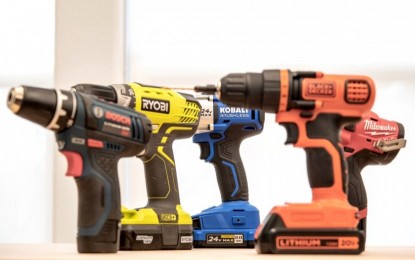
Our Verdict
Our Analysis and Test Results
Drilling
This drill got off to a great start with the 5" hole saw, drilling it to the full depth in the door with only a slight amount of struggling compared to the top-of-the-line tools. It never completely stalled and stopped, but it did take a little more than three times as long as the fastest drills — 50 seconds compared to 17.
It also did very well with the standard twist drills and the steel sheet. It took almost no time at all — 1.8 seconds — to drill a hole with the ¼" drill. The PCCK607LB didn't struggle at all with this, not even binding up when it punched through the sheet into the wood backer board we were using. It did take a little longer with the ½" drill, mainly due to the fact that it took a little time to get the hole started, but it still took less than 10 seconds in total for the PCCK607LB to drill through the steel with the larger bit.
Unfortunately, we weren't quite as enamored with the PCCK607LB's performance when it came to drilling through the 2x12 with a 1" paddle bit. The PCCK607LB seems like it has plenty of power to make it through the board, though we could tell that it was a little underpowered compared to a handful of the others. However, it was the fact that the Porter-Cable tended to stall right as you were punching through the last bit of the board and would violently wrench the handle to the side that caused us to lose some enthusiasm for this tool. Despite that, it still offers a solid all-around drilling performance — as long as you are cautious about it catching as it finishes drilling a hole.
Driving
We used the PCCK607LB to drive tons of these screws into a pair of stacked 2x12s. This drill handled this test with ease, quickly and easily driving the screws with plenty of power to fully set the countersunk screw heads flush with the surface of the board. You can do a gentle controlled drive near the end to ensure you don't set the heads too deep, and the PCCK607LB has more than enough power to stop and restart if you don't set the head deep enough at first — it doesn't need the momentum to drive the head in at the end.
The PCCK607LB also did quite well with a 5" lag screw, though there was a significant increase in the amount of protesting to get it to the full depth. We drilled a pilot hole through a 2x4 into a 4x4 for this test, then set the tool to work on a ½" lag screw. This drill had more than enough power for the start and the middle of this test, but did begin to stall out and struggle towards the end when there was about ½"-1" to go. However, we were able to eventually drive the screw to its full depth; it just took a bit of convincing on our part.
Battery Life
This cordless drill includes a pair of 1.5 Ah batteries, though we did find they take a little longer than average to recharge. It took around 85 minutes to recharge a completely depleted battery with the included charger in our test.
To compare and score effective runtime, we used each drill with a fully charged battery to drive in 16 of the 3" long, #9 wood screws to their full depth and then to drill a trio of 1" holes using the spade bit. We then repeated this until the battery died, awarding points proportional to the number of sets completed. The best drills made it through 10 or more sets, while the PCCK607LB made it through six full sets and a partial set, able to drive in all the screws of the seventh set but died halfway through drilling the first hole.
Convenience
Our last series of tests focused on the various features, functions, and capabilities of each drill that improve their ease of use and productivity. In total, these all account for 10% of the PCCK607LB's final score.
This drill is about average in weight, weighing in at a little less than 3.5 lbs., and includes a belt clip that is mounted near the back of the battery — quite handy when working on a ladder or scaffolding.
The chuck on the Porter-Cable can accommodate a ½" bit or a bit with a ½" shank, and this drill has two different speed ranges or gear ratios. It also has an integrated LED light on the bottom of the drill that does an excellent job lighting up your work area. It stays on for about 20 seconds after releasing the trigger and doesn't create any shadows from the drill or your hand to obscure your view of the hole you are trying to drill or the fastener you are trying to drive in.
It's fairly easy to swap the batteries on this drill, with a locking mechanism that engages or disengages quite easily. However, it can take a little force to slide the battery in or out. We also really liked that this drill has a status indicator on the battery, so you know how much charge you have remaining.
Should You Buy the Porter-Cable 20V Max?
Overall, we were quite happy with the performance of the Porter-Cable 20V Max 1/2 In Drill/Driver Kit PCCK607LB. It didn't do that much worse than the very best high-end drills, all while maintaining a lower price. While it still might be a little too expensive for a budget-conscious person, it's a great option for anyone who is willing to pay a bit more for better performance but is still looking to save some cash. The PCCK607LB is a decent value overall, striking a good balance between a more affordable price and a top-tier performance.
What Other Drill Should You Consider?
There isn't anything wrong with the Porter-Cable, but it isn't a standout, and there are likely better options in the bunch depending on your goals. While it is somewhat less expensive than the top-tier, it isn't that much cheaper to make the savings all that worthwhile. Consider the Craftsman V20 1/2-In. Drill/Driver Kit CMCD700C1 if you're looking for an affordable but well-performing drill.
| Awards | |
|---|---|
| Price | $173 List Check Price at Amazon |
Overall Score  |
|
| Star Rating | |
| Bottom Line | A good choice if you are looking to save some cash over the premium models but still want plenty of power |
| Pros | Good driving power, solid all-around performance, less expensive than premium products |
| Cons | So-so with the spade bit, slow to charge |
| Rating Categories | Porter-Cable 20V Max... |
| Drilling (35%) | |
| Driving (35%) | |
| Battery Life (20%) | |
| Convenience (10%) | |
| Specifications | Porter-Cable 20V Max... |
| Five Inch Hole Saw Test | 50 seconds |
| Lag Screw Test | 5.0 in |
| Manufacturer Peak Torque | 270 in-lbs |
| Measured Charge Time | 85 min |
| Measured Weight | 3.3 lb |
| Measured Length | 7.0 in |
| Clutch Settings | 23 |
| Manufacturer Stated RPM | Low: 0 - 450 High: 0 - 1800 |
| Included Battery Pack(s) | 1.5 Ah |
| Max Chuck | 1/2 in |
| Battery Voltage | 20V |
| Drill Model Tested | PCCK607 |
| Box Model (Kit) Tested | PCCK607LB |
| Battery Indicator Location | Drill |
| LED Location | Above the battery |
| Included Belt Clip | Yes |


